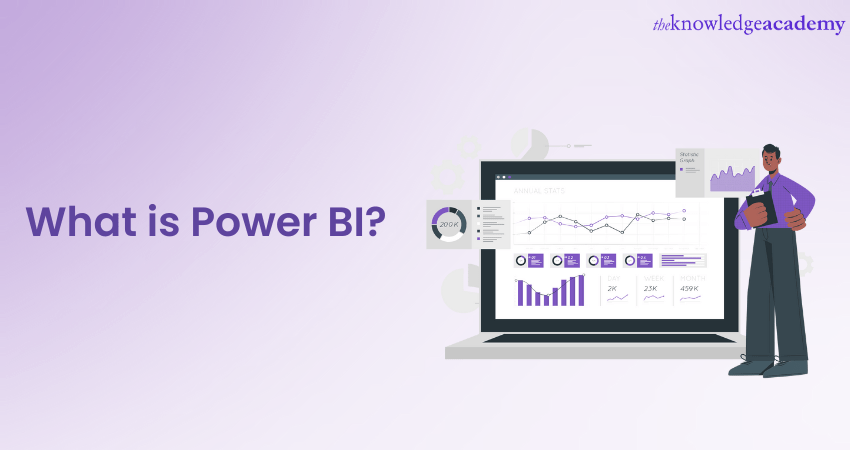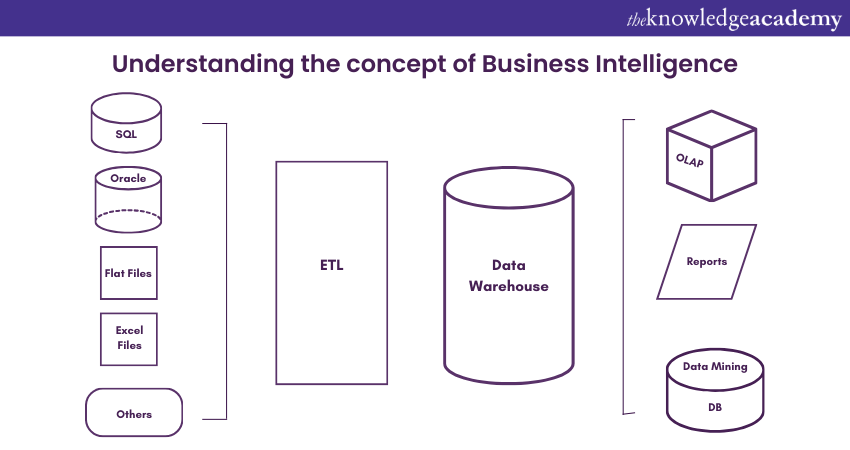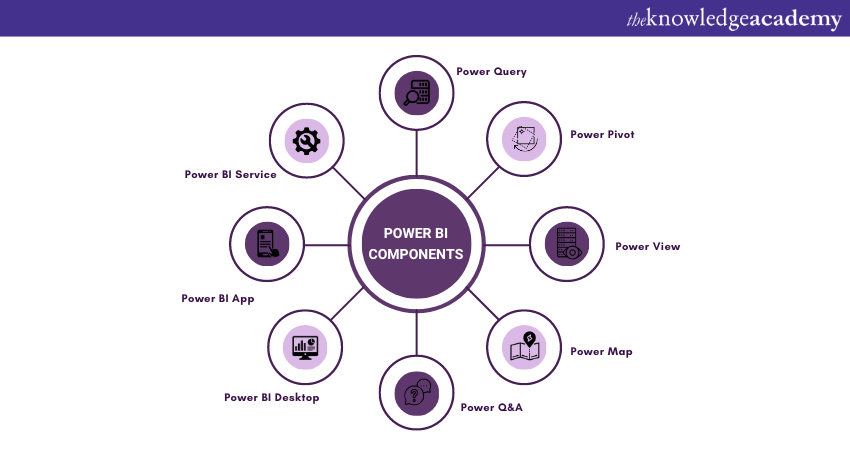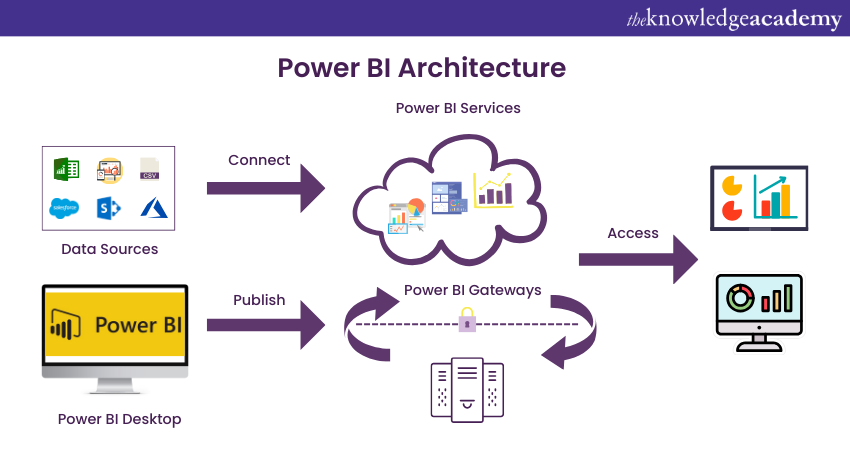We may not have the course you’re looking for. If you enquire or give us a call on 01344203999 and speak to our training experts, we may still be able to help with your training requirements.
Training Outcomes Within Your Budget!
We ensure quality, budget-alignment, and timely delivery by our expert instructors.
- Quick Powerful Graphics with Power View, PowerPivot, Power Query, Power Map and Power BI M55164
- Microsoft Power BI for End Users 55400AC
- Designing and Implementing Enterprise-Scale Analytics Solutions Using Microsoft Azure and Microsoft Power BI DP500
- Microsoft Power BI Data Analyst PL300
- Microsoft BI Training

The certified Power BI professional with exceptional skills has a plethora of job opportunities worldwide. Data Analysis skills and tactics prove to be extremely important to businesses, leading to an enormous rise in demand for Business Intelligence professionals.
With about 36 per cent market share, Power BI has become the most popular and in-demand data-analytic tool among businesses. As per Glassdoor UK, the median annual salary for a Power BI developer was about £47,550 in 2022.
In this blog, you will understand What is Power BI, which is primarily utilised by business analysts and experts. It aids in the discovery of insights within an organisation.
Table of Contents
1) Understanding the concept of Business Intelligence
2) What is Power BI?
3) Reasons to use Power BI
4) Features of Power BI
5) Power BI Components
6) Power BI Architecture
7) Advantages and Disadvantages of Power BI
8) What are the three types of Power BI Licenses
9) Who uses Power BI applications
10) Conclusion
Understanding the concept of Business Intelligence
The term ‘Business Intelligence’ ascribes to technologies, software, and processes that gather unprocessed business data and transform it into informative data. Businesses can use Business Intelligence to combine various datasets, to analyse, evaluate, and present their findings in a visual format.

Business intelligence offers - valuable information that may help businesses make strategic decisions to increase their customer base by creating more value for customers to boost revenue generation.
Custom visualisations are one of the numerous features that Business Intelligence offers a firm. Other features include cloud services and easy access to raw data. Of the several Power BI tools available in the market, Microsoft Power BI is one of the most popular and preferred tools offering several services and features relevant to your business.
What is Power BI?
"Power BI" refers to various software applications, apps, and connectors that analyse data sources and offer pertinent insights and judgments. Created by Microsoft as a component of their Power Platform and is an approachable option for companies to gather, manage, and analyse enormous amounts of data. Power BI collects data from the sources, automatically evaluates it, and then provides users with pertinent insights, typically as graphs and charts.

Reasons to use Power BI?
There are many reasons why organisations choose to adopt the Power BI service for their business benefits. Here is a list describing the reasons for Power BI’s popularity::
a) Accessibility to datasets from various sources: Organisations can gain access to large volumes of data from various sources by using Power BI. The service basically allows them to view the data, analyse it and visualise massive quantities of data which can otherwise not be opened in Microsoft Excel. Few of the notable data sources available for companies to use through Power BI are Microsoft Excel, XML, CSV, JSON, PDF and more. Moreover, the service also applies compression algorithms designed to import and cache the extracted data into a .PBIX file.
b) Interactive UI/UX features: The Power BI service makes business processes visually appealing for organisations. It offers users with an easy functionality to drag and drop components and various other aspects of the workspace. The service essentially allows them to copy all the necessary formatting across other similar visualisations.
c) Exceptional software integration with Excel: Power BI is designed to help organisations in gathering, analysing, publishing and sharing their business data with other account users who are stakeholders and team members. Any user who is familiar with the Microsoft Office 365 service have the option to seamlessly connect their queries from Excel, data models and reports to their dashboards in Power BI.
d) Accelerated Big Data preparation with Azure: Organisations can seamlessly analyse and share large volumes of data. The Azure Data Lake service reduces the amount of time consumed to retrieve data-driven insights and enhance the collaborative structure among Business Analysts, Data Engineers and Data Scientists. The Data Lake basically eliminates all complexities pertaining to the ingestion and storage of user data, resulting in a faster operation of batch, streaming and interactive data analytics.
e) Transform insights into action: Organisations can gain data-driven insights and transform them into actions that help them make better business decisions pertaining to their data. Large-scale scenarios involving business strategies have a better chance of coming up with a successful program to make the best decisions.
f) Stream analytics for data in real-time: Users of Power BI are provided the functionality to perform their data stream analytics in real time. This accelerated process helps them extract the required data from various sensors and sources on social media to gain access to data analytics procedures in real-time. This leverages their decision-making process to optimise their business outcomes.
Features of Power BI
Power BI offers a myriad of features to its users, which are described in the list below as follows:
Power BI Desktop
Organisations and other users are offered a software at no cost, called the Power BI Desktop, which can they simply download and install. The software allows them to design reports through seamless access to data. Users are not required to carry out advanced levels of report designing procedures or querying skills for building a report.
Stream analytics
Users of Power BI are equipped with the primary advantage of exploiting the software’s support for real-time streaming analytics. Ranging from multiple factory sensors to social media sources, users are provided with complete assistance in real-time analytics of their data in order to make better-informed and timely decisions.
Multiple data sources
Users are given full support for many of their data sources, which is a primary and core feature of the Power BI service. They are allowed to have access to many sources of data like CSV, Excel, Microsoft SQL Server, Web files and more. This native support and integration help users create better and enhanced interactive visualisations. It especially aids users to eliminate any data silos, which are basically sources of data within their organisation which are not connected to any other sources of data. Power BI allows users to utilise the software service’s on-premises data gateway for the purpose of merging or appending their cloud and on-premises sources of data within the same query.
Custom visualisation
Users will be dealing with large volumes of complex datasets from their many data sources. In such scenarios, the default standard of Power BI may not suffice for their operational needs, in which case they can gain access to the customised library for visualising their data as per their business requirements. Moreover, this very library offers users with a rich range of open-source tools to create stellar visualisations with the support of popular JavaScript libraries like jQuery, D3 and also scripts written in the R language.
Dissect Business Reporting with our comprehensive Business Intelligence Reporting Training today!
Power BI components
Here you will learn about the Power BI components and their capabilities:

What is Power BI Query?
You can gather, transform, and analyse information from multiple sources to the data into a single platform.
What is Power BI Pivot?
A data modelling technique to develop simple and complex data models using DAX (Data Analysis Expression). The Power BI Pivot can help you set up relationships between different data sources by carrying out a numerical computation.
What is Power BI View?
By adding Power BI View on Spread Share or SQL Server - You can create maps, charts, and graphs with simple drag-and-drop features.
What is Power BI Map?
This component proves helpful when you want to retrieve sales information from certain specific locations. Power Map aids you in gathering millions of rows of data in 3D visualisation format on Bing Maps. You can extract exact geospatial visuals on Bing Maps based on latitude, longitude, and country names.
What is Power BI Q&A
Once the Power BI model is built and deployed, you can access the data by giving voice commands or writing in your own words. The Power BI Q&A integrates with Cortana (Virtual Assistant) by using Natural language processing to find answers to the query inquired.
What is Power BI Desktop?
Power BI Desktop can help you integrate Power Pivot, Power View, and Power Query on a single platform.
It is an application that can be installed for free on a laptop or computer to create reports and dashboards. Power BI Desktop offers you a 1GB uploading limit and up to 10GB data storage at a time in its free version. It gives you access to all features of Power BI Visualisation libraries and templates.
What is Power BI App?
Power BI App provides access to dashboards and live reports, available for Windows, iOS, and Android devices. Irrespective of whether your data is stored on-premises or cloud, you can share & access reports, run queries and get personalised notifications.
What is Power BI Service?
Power BI Service, hosted on Azure, enables you to publish and share reports on the cloud with other members. You can produce real-time reports and link them to the Power BI Workspace/Dashboards.
Power BI Service enables you to access the data from anywhere by integrating Power View, Power Pivot, Power Q&A, Power BI Report Server, and other components with the Power BI Workspace. Power BI Report Server lets you connect and see On-premises data in your web browser.
Learn the latest concepts and upskill with Microsoft BI Training, now!
Power BI Architecture

The Power BI architecture is a service based on Azure. Power BI can connect to a variety of data sources.
You can create data visualisations on the dataset & reports in Power BI Desktop. On-premises data sources are linked to the Power BI gateway to provide continuous data for reporting and analytics. The cloud services used to produce Power BI reports and data visualisations are referred to as Power BI services. You can stay connected to their data from anywhere by using Power BI mobile apps.
Advantages and Disadvantages of Power BI
|
Advantages of Power BI |
Disadvantages of Power BI |
|
Affordability: Compared to other cloud service providers, Power BI is inexpensive. You can download and create reports on your computer, as access to the Power BI Desktop version is free. However, charges will be applied if you share your reports on the cloud. |
Rigid formulas and large data volumes: Power BI majorly uses DAX language. This language can be used to perform many actions, permitting you to create multiple customised calculations. But due to its rigidity, it sometimes becomes awkward and inconvenient, resulting in delays and underperformance of the dashboard. Power BI has set a limit on the size of the data you can thrust in. You need to update from the free version to the paid version for importing data larger than 2GB. At times it can crash while processing large & complex data files. |
|
Custom Visualisation: Power BI Visualisation format offers a wide range of custom visualisations for developers to convert your requirements to maps, charts, graphs, etc. |
User Interface: The view of reports and dashboards in Power BI is blocked and looks cramped with many icon options. Also, the Tooltip has limited usability in Power BI. |
|
Excel is Integrated: With Power BI, you have the option to save data to Excel. Many people tend to have the data in their excel sheet. Hence, data visualisation tools can aid you in explicitly presenting the data using graphs, maps, and charts in excel format. This data will be accessible to you from Power BI regardless of your location & time.
|
Complex Table Relationships: Sometimes Power BI can face problems in managing data with complex correlations and structure between the tables. Moreover, you need to focus on directing the data models carefully, enabling Power BI to appropriately distinguish the relations with the tables. |
|
Data Accessibility and Interactive Visualisation: Power Business Intelligence provides access to all the data sources created while designing the dashboards & reports to interact seamlessly. You are privileged to access the data stored in the centralised location any number of times, from any device, at any time, and anywhere. |
Limitation in Excel Integration: At times, the excel integration is an advantage. But there is a limitation in downloading data, as you can download only up to 150,000 rows of data. |
|
Upgraded Features: Microsoft provides users with monthly updates. Overall, for data analysis and visualisation, Power BI is an impressive tool. |
Compatibility with Mac/IOS: Mac Users having a Desktop version rejects compatibility with Power BI. |
Career Opportunities in Power BI
As business operations are getting more complex with an increased user base and data generation, companies are now using Business Intelligence tools for real-time data visualization and making better market decisions.
As the industry pioneer in business analytics, Microsoft Power BI is now preferred by numerous large corporations and businesses. Additionally, because the technology is new, there is a tremendous need for qualified BI Analysts. Therefore, if you are considering starting or changing your career in business intelligence, this is the right time.
With good knowledge of Power BI and related terminology, you can apply for different job roles as listed below:
Power BI Developer
A Power BI Developer is accountable for developing, designing, and maintaining Business Intelligence solutions. As per the business requirements, these professionals create and improve technical documentation.
The professional Power BI Developer has immense knowledge of Business Intelligence systems and has acquired a knack for solving the queries of Users. Having extensive knowledge of operating systems, networking, databases, cloud architecture, and Business Intelligence is the minimum apprehension expected from Power BI Developers.
Power BI Analyst
A Business Intelligence Analyst collects corporate data using various methods, such as data mining and current trends and visualises the company's competitiveness with other market players. Additionally, a Power BI Analyst looks out for the new capabilities in the latest released version and determines how they can benefit the company.
The Business Analyst develops reports based on customer requirements so that decision-makers can make better judgments and boost the company's profitability.
Power BI Consultant
A Power BI consultant assesses the current setup and, if required, installs new systems. The person is also in charge of creating a high-level plan/roadmap for achieving the objectives and balancing client requirements with technical limitations.
Power BI Manager
Business Intelligence Managers are experts with years of experience working as Power BI Developers or BI Analysts. The managers direct the data strategy and oversee the BI team's numerous operations.
Through dashboards and customised reports, a BI Manager assists decision-makers and stakeholders in understanding the current state of the business so they can make data-informed decisions.
Brush up on Interview skills with Power BI Interview Questions and Answers.
What are the three types of Power BI licenses?
Power BI offers its users with a desktop version coupled with the pro and premium versions:
Power BI Desktop – Free version
One of Power BI’s versions is the free one, which is best suited for individual users, and is designed with native support for developmental functionalities. A drawback of the Power BI Desktop version is that it does not allow users to share their data on the cloud.
Additionally, it allows its users to generate their reports on a desktop or a laptop, also called a host or local machine. It is also capable of integrating with various data sources, and equips users with upto 1GB of cloud storage for their reports and other data content.
Power BI Pro
Another version of Power BI is its Pro version, which is available to users at a subscription of 8.24 GBP per month. The subscription offers them with all the available functionalities of the Power BI version, along with being able to share data reports with other users of the Pro version. Each user is provided a maximum of 10GB storage for their data and can also export their reports onto a Sharepoint website.
Power BI premium
The third version is the premium model of Power BI, which comprises of two options, the Individual and Enterprise model. An individual Power BI user can subscribe to a license of 16.7 GBP per month, and both options provide all available functionalities such as increased storage, options to refresh data schedules and data sharing with other users.
Who uses Power BI applications?
Power BI is intended for use by industries for their Data Analytics purposes. Such industries span domains like IT, Healthcare, E-Commerce, Finance, Space and more. They utilise the tools of Power Bi to generate data models and information visualisations with the support of customisable dashboards.
Here is a list describing three companies using Power BI:
Cognizant Vehicle 360 in automobiles
Cognizant’s Vehicle 360 offers data analytics services to many enterprises across the automotive industry, consumer sectors and fleet operators. It helps them better comprehend performance of vehicles, reduction in operational and maintenance costs and suggestions for optimum driving parameters
Hitachi solutions in finance
The Japanese multinational electronics company devised a solution with the use of Power BI that facilitates a direct connection between banks and cloud-based data sources. This connection enables decision-makers to better understand the performance of their business, analyse their project pipeline and make optimised decisions for better profitability.
RADACAD Labour Market Analysis – Government
A quarterly employment survey was conducted by RADACAD to utilise the data sourced from the state government and came up with an estimation of the average hourly earnings of the labour market in New Zealand. The data report intended to provide the status of employment pertaining to citizens employed across various industries in New Zealand.
Conclusion
After reading this post, you should now be able to identify the need for Power BI in business intelligence, understand what Power BI is and its many features, and understand Power BI architecture. Finally, developing several visualisations with Power BI Tools allows even a non-technical user to build interactive dashboards, perform complex analyses, and create live reports with Power BI.
Create dashboards that give rise to useful insights with our Microsoft Power BI Course today!
Frequently Asked Questions

Power BI is designed to establish connections with numerous data sources, while Microsoft Excel is designed with limited capacity. While both are intended as Business Intelligence tools, their functional capacity is quite distinct. Power BI is much better suited to analyse large datasets and obtaining valuable insights, and Excel is capable of letting its users manipulate and format small-sized datasets. Users will experience distinct approaches to visualising their data, where Power BI enables the creation of dynamic and interactive visualisations and Excel is pivotal on static charts and graphs.

No, users do not need to apply any programming language for operating Power BI. The service requires the use of formula-based language such as Data Analysis Expressions (DAX) and M. Although it does not offer users the entire range of possibilities with coding languages, the available scope of functions can suffice for transforming, modelling and visualising data.

Power BI lets users customise their dashboards and generate data reports in meaningful and interactive ways. It also facilitates real-time data processing, which entails that users can access the latest data from their dashboards as well as reports. The USP of the service is giving its users the full agency on sharing and exchanging their work. They can create their workspaces for collaborating with their colleagues on the dashboards, following which they can even bundle and distribute them as applications.

The top benefits of Power Bi include image recognition, text analytics, Machine Learning models and integration with Azure Machine Learning. Power BI also helps users handle significant volumes of data and cuts down the time consumed to extract data-driven insights, better collaboration amongst Data Engineers, Data Scientists and Business Analysts. Moreover, the service also keeps the workspace visually aesthetic, with user-friendly drag and drop functionality with great features to copy the necessary formatting across all visualisations. More importantly, using Power BI does not burn a hole in any pockets, because it is budget-friendly for small to mid-sized businesses.

The Knowledge Academy takes global learning to new heights, offering over 30,000 online courses across 490+ locations in 220 countries. This expansive reach ensures accessibility and convenience for learners worldwide.
Alongside our diverse Online Course Catalogue, encompassing 17 major categories, we go the extra mile by providing a plethora of free educational Online Resources like News updates, blogs, videos, webinars, and interview questions. Tailoring learning experiences further, professionals can maximise value with customisable Course Bundles of TKA.
The Knowledge Academy’s Knowledge Pass, a prepaid voucher, adds another layer of flexibility, allowing course bookings over a 12-month period. Join us on a journey where education knows no bounds.

The Knowledge Academy offers various Business Intelligence Reporting courses, including Business Objects Reporting, Crystal Reports Masterclass, Cognos BI Training and Tableau Desktop Training. These courses cater to different skill levels, providing comprehensive insights into Business Intelligence Reporting methodologies.
Our Business Intelligence Reporting blogs cover a range of topics related to Power BI, offering valuable resources, best practices, and industry insights. Whether you are a beginner or looking to advance your Business Intelligence Reporting skills, The Knowledge Academy's diverse courses and informative blogs have you covered.

The Knowledge Academy’s FlexiPass is a pre-paid training voucher that is built specifically for clients and their dynamic needs. It provides access to a wide range of courses, at a pre-determined price, with robust safety measures. FlexiPass gives clients the added benefit of upskilling on a budget that best fits them.
Upcoming Office Applications Resources Batches & Dates
Date
 Microsoft Power BI Course
Microsoft Power BI Course
Wed 7th Aug 2024
Wed 21st Aug 2024
Wed 4th Sep 2024
Wed 18th Sep 2024
Wed 9th Oct 2024
Wed 23rd Oct 2024
Wed 6th Nov 2024
Wed 20th Nov 2024
Wed 4th Dec 2024
Wed 11th Dec 2024
Wed 18th Dec 2024
Wed 15th Jan 2025
Wed 5th Feb 2025
Wed 12th Mar 2025
Wed 9th Apr 2025
Wed 21st May 2025
Wed 11th Jun 2025
Wed 16th Jul 2025
Wed 6th Aug 2025
Wed 10th Sep 2025
Wed 8th Oct 2025
Wed 12th Nov 2025
Wed 3rd Dec 2025







 Top Rated Course
Top Rated Course


 If you wish to make any changes to your course, please
If you wish to make any changes to your course, please


